Sunseed News, Sustainable Living
Bulgarian Kids visiting Sunseed
In early November, Sunseed was really lucky to welcome 10 Bulgarian kids and their lovely teachers.
We created a varied program all connected to sustainability as the group was on a mission through Spain all about this topic. They stayed four 4 days and got a broad expression of how life in Sunseed is lived.
From natural tie dyeing to herbal salt-making from our gardens over self-made pomegranate juice and sauerkraut.
Following we will show some short cuts of the different workshops which were provided by our interns and volunteers.
Natural tie-dyeing
The textile industry has a huge impact to the environment. Their actions highly affect the surrounding around the factories where they are producing.
Even though some companies are using some processes to clean the water before leading it back to the ecosystems, it still needs a lot of energy- and water resources, and mostly the fluids which are led back to the rivers are not fully cleaned of chemicals and heavy metals.
And something else must be mentioned: a lot of companies do not clean the water before leading it back.
Especially talking about factories in countries like Bangladesh or Philippines as they have not such strong environmental policies or even when they have, there is often a lack of authorities who make sure that those policies get respected.
We were trying to show the kids an alternative to dying clothes with natural colors which we were producing ourselves to use resources in a closed circle. What does that mean? The water we use for dyeing the fabric can just go back into the system without harming our environment because we used only natural products as onion peels, avocado peel and the juice of prickly pear.
Our interns were preparing the colors two days before the actual workshop took place.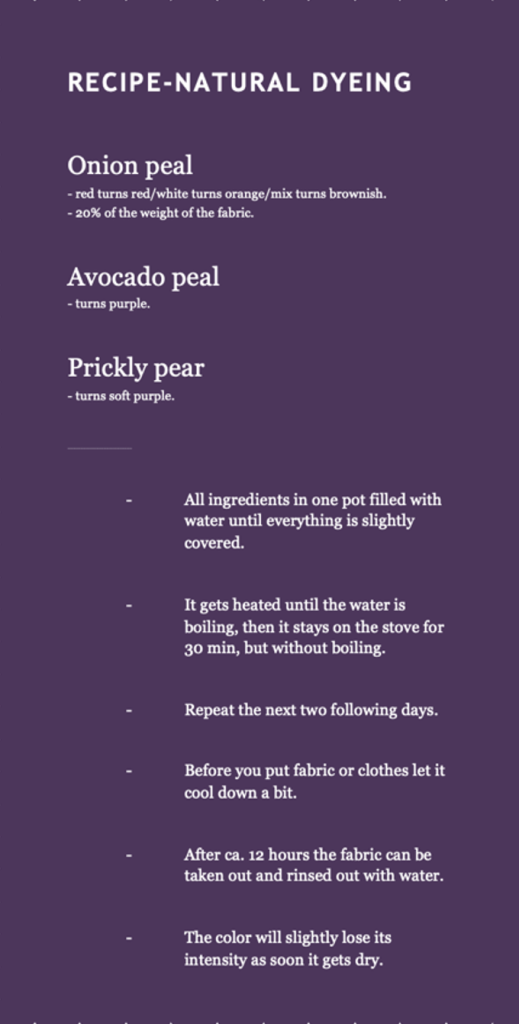
After a short theoretical part, the kids tied strings in different ways to a big piece of fabric to create a nice pattern.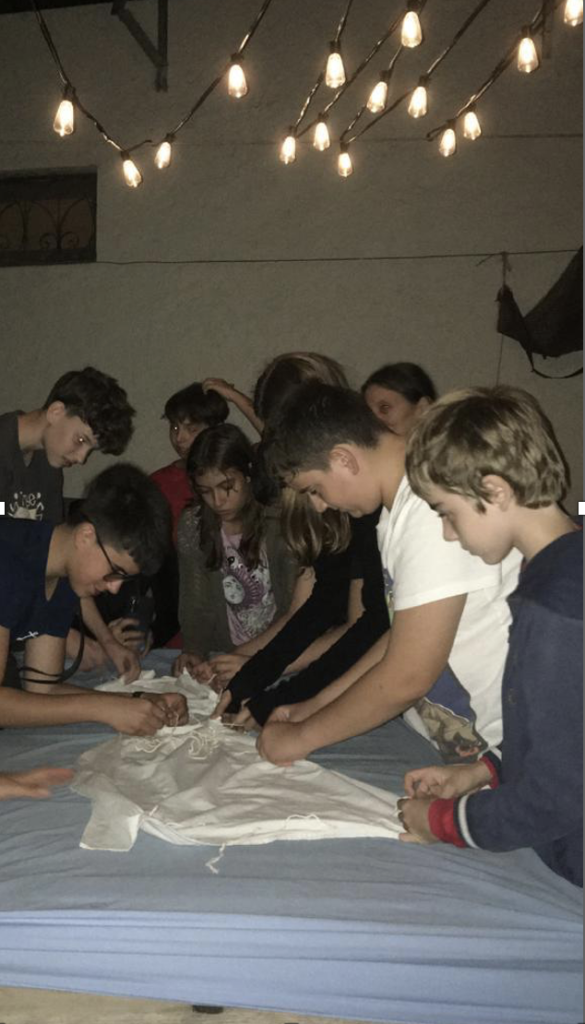
Afterwards they put the fabric into the color to let it sit there for around 12 hours. The next day we took it out and were surprised by the result.
Each one got a piece of fabric to sew a small bag to put self-made herbal salt in.
Which leads to the next workshop…
Gardening
One part of the gardening workshop was collecting aromatics from Sunseed’s Medicinal Gardens (Lavender, Rosemary, Vervain) and talking about everything you can do with them as preparations for the gardens, for cooking or cosmetics. Those herbs got mixed with salt and processed in mortars. We used the previously tie-dyed bags to put the salt inside. Besides that, we had a walk through the gardens and talked about easy learning about natural biodiversity (spontaneous plants, flowers, pollinators and auxiliary flora and fauna) in our surroundings and how much fun it can be to grow your own healthy food. We did some action and planted calendula seeds in our greenhouses where we also had a talk about how to prepare and plants seeds. We took some baby-plants from our seedlings and transplanted them with some compost and watered with comfrey tea. We talked about their good properties and how to do your own preparations to prevent pests and to provide healthy soil. 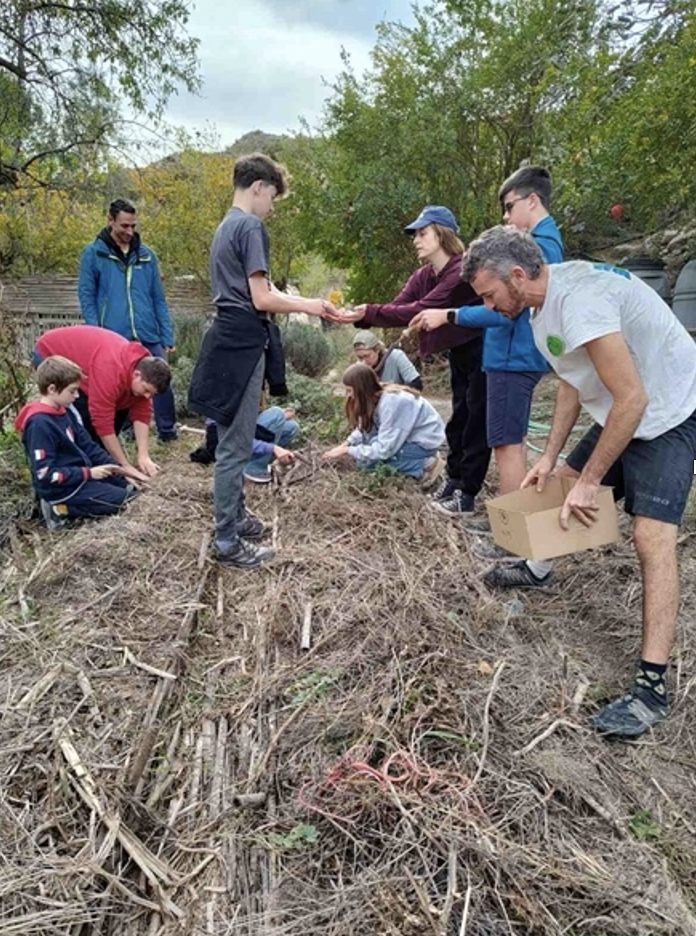
Sauerkraut and juice making
In this activity we introduced the kids to the world of homemade and plant based delights. Specifically, we showed them how to easily make sauerkraut, using the traditional recipe of one of our German intern’s grandmother, and pressing pomegranate juice at home. The cabbage and pomegranates we used are from the nearby farmer Jacky, who provides us weekly with regional and seasonal fruits and veggies.
As the kids started enthusiastically shredding the cabbage, we asked them about their knowledge on sauerkraut. Some of the kids actually knew what the process is all about. Sauerkraut is made through the fermentation of cabbage. The naturally present bacteria is transforming the sugars of the cabbage, processing them into gas and acid, which is what makes the sauerkraut sour. While the kids massaged the cabbage, we explained the significance of the bacteria for their guts, as they help breaking up and digesting the nutrient-rich cabbage. This leads to a better intake of the vitamins and minerals, such as vitamin c and iron, supporting the immune system. After the kids were done massaging the cabbage and pressing it into the jars, they were fascinated by how this simple process could lead to such a delicious and nutritious treat.
The juice making activity helped the kids reflect on where the fruit and veggies they see in supermarkets and usually consume actually come from and the differences between store-bought and homemade juice. Southern Spain offers an abundance of pomegranate trees – we even have a few growing in the Sunseed garden. They realized how much effort it takes to get this sweet and refreshing treat, especially when we cannot rely on energy intensive appliances like a juicer. The process involved cutting the pomegranates in halves, squeezing them with a manual press, collecting the leftover seeds which would again be squeezed by hand using a cloth. They showed a lot of excitement and realized how rewarding it is to be so closely involved in the process of making your own delicious foods and beverages.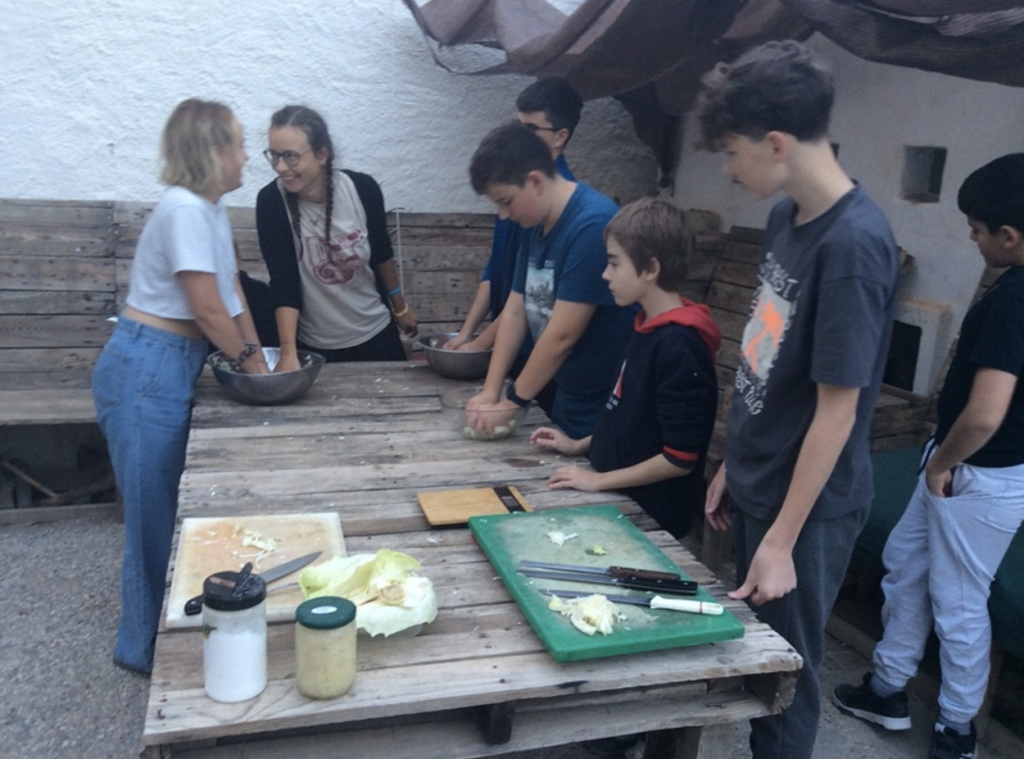
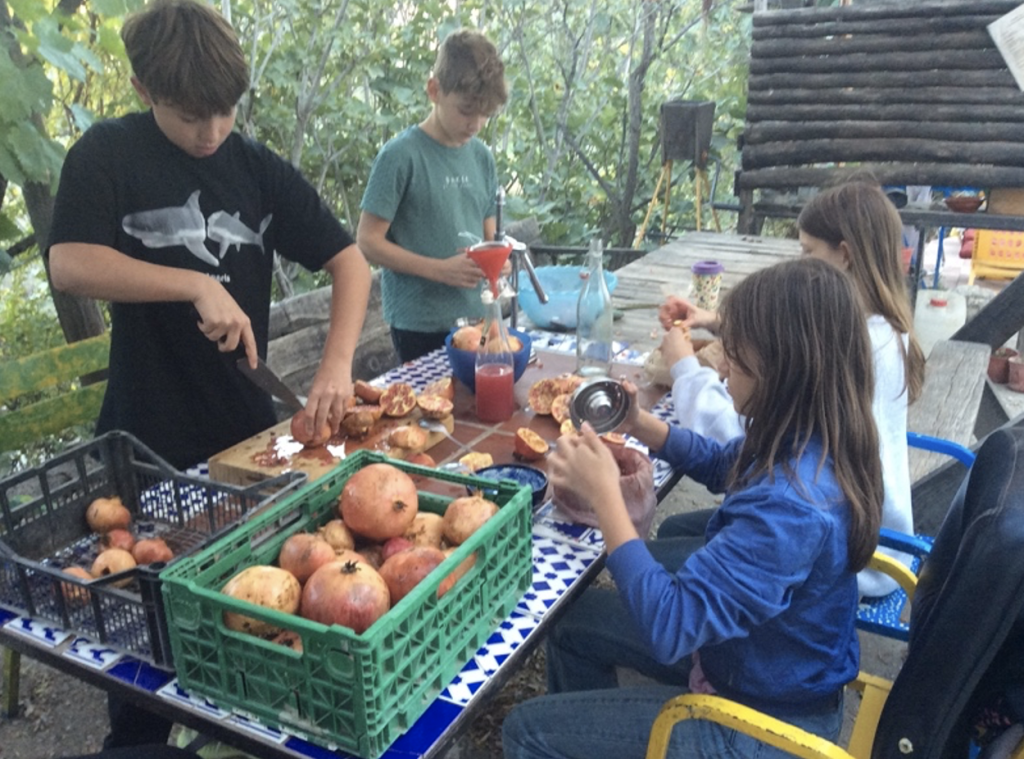
======
(ES)
El pasado noviembre Sunseed tuvo la gran suerte de dar la bienvenida a 10 niños búlgaros y a sus encantadoras profesoras. Creamos un programa variado, todo relacionado con la sostenibilidad, ya que el grupo estaba en una misión por toda España sobre este tema. Estuvieron aquí durante 4 días y obtuvieron una amplia experiencia de cómo se vive la vida en Sunseed. Desde la tintura natural de telas hasta la elaboración de sal de hierbas de nuestros jardines, pasando por el zumo de granada casero y el chucrut. A continuación, se mostrarán algunos fragmentos de los diferentes talleres que fueron ofrecidos por nuestros becarios y voluntarios.
La industria textil tiene un gran impacto en el medio ambiente. Sus acciones afectan en gran medida el entorno alrededor de las fábricas donde se producen. Aunque algunas empresas utilizan procesos para limpiar el agua antes de devolverla a los ecosistemas, todavía se requieren una gran cantidad de recursos energéticos y hídricos, y en su mayoría, los líquidos que se devuelven a los ríos no están completamente libres de productos químicos y metales pesados. Y lo que debe mencionarse: muchas empresas no purifican el agua antes de devolverla. Especialmente al hablar de fábricas en países como Bangladesh o Filipinas ya que no tienen políticas ambientales sólidas o, incluso si las tienen, a menudo faltan autoridades que se aseguren de que se respeten esas políticas.
Tratamos de mostrar a los niños una alternativa para teñir la ropa con colores naturales que producíamos nosotros mismos para utilizar los recursos en un ciclo cerrado. ¿Qué significa eso? El agua que usamos para teñir la tela puede regresar al sistema sin dañar nuestro entorno porque solo usamos productos naturales como cáscaras de cebolla, cáscaras de aguacate y jugo de higo chumbo. Nuestros becarios prepararon los colores dos días antes de que se llevara a cabo el taller.
Después de una breve parte teórica, los niños ataron un trozo grande de tela con cuerdas de diferentes maneras para crear un bonito patrón. Después, colocaron la tela en el tinte y la dejaron reposar durante aproximadamente 12 horas. Al día siguiente, la sacamos y nos sorprendimos con el resultado. Cada uno recibió un trozo de tela para coser una pequeña bolsa y poner en ella sal de hierbas hecha por ellos mismos. Lo cual nos lleva al próximo taller…
En esta actividad, introdujimos a los niños al mundo de las delicias caseras y basadas en plantas. Específicamente, les mostramos cómo hacer chucrut fácilmente, utilizando la receta tradicional de la abuela de una de nuestras becarias alemanas, y cómo exprimir zumo de granada en casa. El repollo y las granadas que utilizamos son de Jacky, una agricultora cercana que nos provee semanalmente con frutas y verduras regionales y de temporada.
Mientras los niños comenzaban entusiasmados a rallar el repollo, les preguntamos acerca de sus conocimientos sobre el chucrut. Algunos de los niños sabían en qué consiste el proceso. El chucrut se hace mediante la fermentación del repollo. Las bacterias naturalmente presentes transforman los azúcares del repollo, convirtiéndolos en gas y ácido, lo que hace que el chucrut tenga un sabor agrio. Mientras los niños masajeaban el repollo, les explicamos la importancia de las bacterias para sus intestinos, ya que ayudan a descomponer y digerir el repollo rico en nutrientes. Esto conduce a una mejor absorción de vitaminas y minerales, como la vitamina C y el hierro, que apoyan el sistema inmunológico. Después de que los niños terminaron de masajear el repollo y de colocarlo en los frascos, quedaron fascinados de cómo este proceso simple podría llevar a una delicia tan deliciosa y nutritiva.
La actividad de hacer zumo ayudó a los niños a reflexionar sobre de dónde provienen las frutas y verduras que ven en los supermercados y consumen habitualmente, así como las diferencias entre el jugo comprado en tiendas y el casero. El sur de España ofrece una abundancia de árboles de granada; incluso tenemos algunos creciendo en el jardín de Sunseed. Se dieron cuenta de cuánto esfuerzo se necesita para obtener esta golosina dulce y refrescante, especialmente cuando no podemos depender de electrodomésticos intensivos en energía como un exprimidor. El proceso implicaba cortar las granadas por la mitad, exprimirlas con una prensa manual, recoger las semillas sobrantes que luego se exprimirían a mano con un paño. Mostraron mucha emoción y se dieron cuenta de lo gratificante que es estar tan involucrados en el proceso de hacer tus propios alimentos y bebidas deliciosos.
